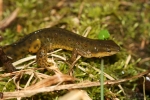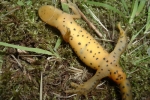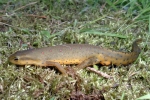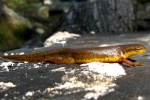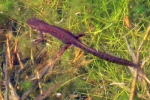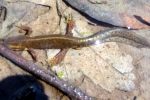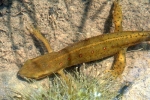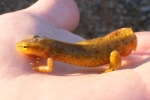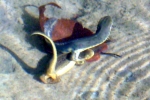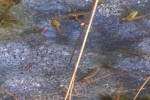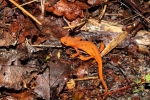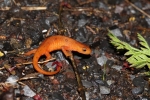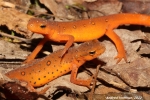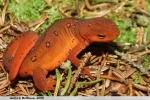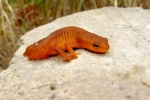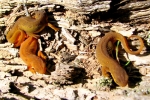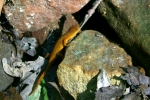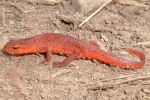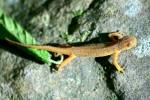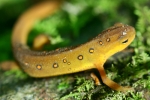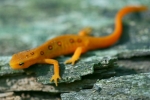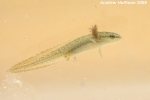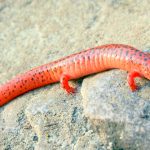Red-spotted Newt

Scientific Name: Notophthalmus v. viridescens
Size: 2-4.5 inches (5.5-12 cm) in length
Status: Abundant
Habitat:
Ponds, lakes, slow-moving streams and creeks.
Description:
Moderate-sized species. The eastern newt has three life stages that have different characteristics.
Adult - The background color olive green to yellowish brown. The skin is slightly granular with small black spots and blotches scattered over the body. The sides have a series of red spots that are bordered by black. The tail is narrowly keeled and compressed laterally with a variably developed caudal fin. The body is rounded. The head is barely distinct from the neck.
Terrestrial Sub-adult (red eft) - The background color is light orange to dull red that becomes lighter ventrally. There are two series of light reddish to orange spots that are bordered with black that extend along the dorsolateral surface. Small black spots may also be present on the dorsal. The underside is immaculate, but may have small black spots. The body is more rounded than that of an adult. The tail is round in the cross-section. The legs are large and well-developed.
Larvae - The dorsal is light brown to yellowish brown. A dark stripe extends from the snout though they eyes. The underside is light and scattered with black spots. The body is elongate and thin and triangular in the cross-section. The caudal fin and dorsal fins are well-developed. The gills are well-developed.
Adult Coloration:- Aquatic Adult Colorations:
- The dorsal background color olive green to yellowish brown.
- The skin is slightly granular with small black spots and blotches scattered over the body.
- The sides have a series of red spots that are bordered by black.
- The tail is narrowly keeled and compressed laterally with a variably developed caudal fin.
- The body is rounded.
- The head is barely distinct from the neck.
- The dorsal background color is light orange to dull red that becomes lighter ventrally. There are two series of light reddish to orange spots that are bordered with black that extend along the dorsolateral surface. Small black spots may also be present on the dorsal.
- The ventral is immaculate, but may have small black spots.
- The body is more rounded than that of an adult.
- The tail is round in the cross-section.
- The legs are large and well-developed.
- The dorsal is light brown to yellowish brown.
- A dark stripe extends from the snout though they eyes.
- The ventral is light and scattered with black spots.
- The body is elongate and thin and triangular in the cross-section.
- The caudal fin and dorsal fins are well-developed.
- The gills are well-developed.
- The dorsal background color is yellowish green with two dark broad bands that extend on both sides of the back.
- Balancers and forelimb buds are developed.


References:
- Hulse, C. and McCoy C. J. and Ellen Censky ,1998. Amphibians and Reptiles of Pennsylvania and the Northeast. 66-70pp.
- Petranka, James W. ,1998. Salamanders of the United States and Canada. 451-462pp.
- Jason Poston
- John Smith
- Bob Hamilton
- Kyle Loucks
- Billy Brown
- Tom Diez
- Wayne Fidler
- Don Becker (psychoticnature.com)
- Andrew Hoffman
- Stephen Staedtler
Heads up!
Please contribute your observation of this and other herps to the Pennsylvania Amphibian and Reptile Survey. Your help is needed.
